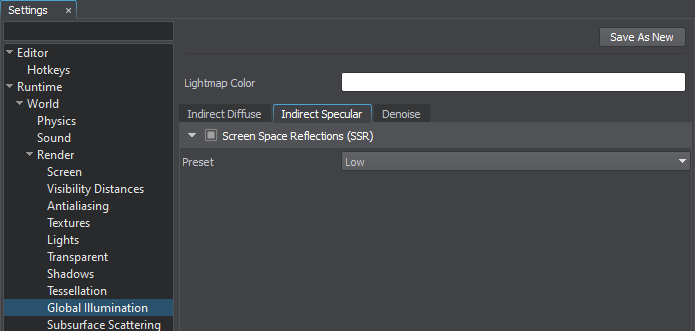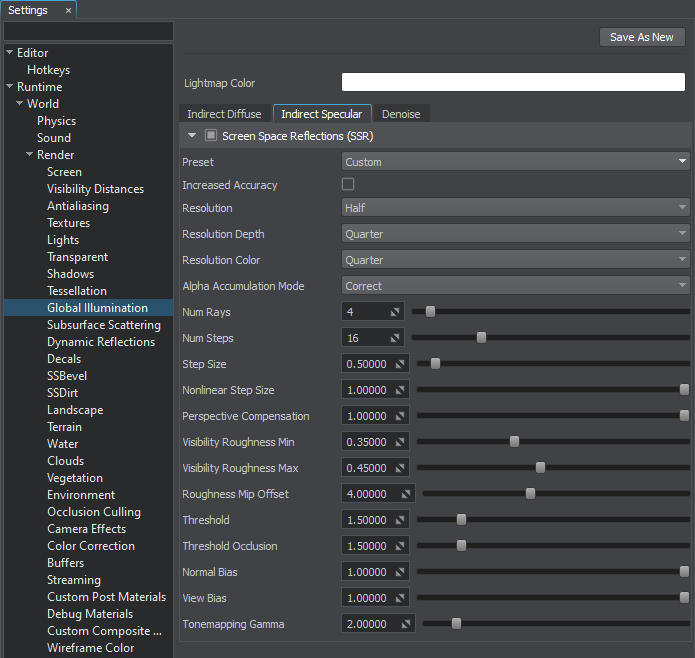SSR
The section contains settings that control screen-space reflections (SSR). These settins are available on the Indirect Specular tab.

| Screen-Space Reflections (SSR) | The value indicating if the SSR (Screen Space Reflections) effect is enabled. disabled by default.
Console access: render_ssr (API control) |
|---|---|
| Preset | The SSR (Screen-Space Reflections) preset used at the moment. To customize the SSR effect options at run time you should activate the Custom preset: One of the following values:
Console access: render_ssr_preset (API control) Notice
Presets override user-defined custom settings. When any preset other than Custom is active, modification of the parameters via API has no effect. The parameter value set via the last API call shall be used only when the Custom preset is active. When checking the current parameter value via API you'll get the corresponding setting stored in the active preset (default or custom one). |
Customizable Settings#
The following settings are available when the Custom preset is selected.

Screen-Space Reflections Settings
| Increased Accuracy | The value indicating if increased accuracy option is enabled for the SSR (Screen Space Reflections). This option increases the accuracy of intersection detection between the ray and surfaces, which makes a reflection on smooth surfaces more detailed. disabled by default.
Console access: render_ssr_increased_accuracy (API control) |
|---|---|
| Resolution | The resolution of SSR (Screen Space Reflections). One of the following values:
Console access: render_ssr_resolution (API control) |
| Resolution Depth | The resolution of the depth buffer used for SSR (Screen Space Reflections) calculation. It affects detailing of reflections of tiny objects. Notice One of the following values:To gain performance, this option can be set to lower values while enabling increased accuracy (see the SSRIncreasedAccuracy).
Console access: render_ssr_resolution_depth (API control) |
| Resolution Color | The resolution of the color buffer used for SSR (Screen Space Reflections) calculation. It significantly affects performance. One of the following values:
Console access: render_ssr_resolution_color (API control) |
| Alpha Accumulation Mode | The accumulation mode for Alpha values used when rendering screen-space reflections. Two modes are available:
Console access: render_ssr_alpha_accumulation_mode (API control) |
| Num Rays | The number of SSR rays per pixel that are used to calculate rough refrections. Using more rays provides more precise SSR roughness calculation, however, it is more expensive. Range of values: [1, 64]. The default value is : 4. Console access: render_ssr_num_rays (API control) |
| Num Steps | The number of SSR steps per ray that are used for trace calculation. The number of steps defines accuracy of reflections and causes a reasonable performance impact. The higher the value, the more accurate obstacles between objects are accounted. Range of values: [1, 64]. The default value is : 16. Console access: render_ssr_num_steps (API control) |
| Step Size | The size of the trace step used for SSR calculation. Higher values result in longer traces (however, tiny objects may become missing), lower values produce more detailed reflections of tiny objects. Range of values: [0.0f, inf]. The default value is : 0.5f. Console access: render_ssr_step_size (API control) |
| Nonlinear Step Size | The linear step size for the SSR effect. At 0.0f, all raymarching steps are of the same size. At 1.0f, each raymarching step is longer than a preceding one, which allows increasing the ray length while keeping the same number of raymarching steps. Range of values: [0.0f, 1.0f]. The default value is : 1.0f. Console access: render_ssr_non_linear_step_size (API control) |
| Perspective Compensation | The perspective compensation value for the SSR effect. At 0.0f, the raymarching step size doesn't depend on the distance from the reflecting surface to the camera. At 1.0f, the raymarching step size linearly depends on the distance from the reflecting surface to the camera. Range of values: [0.0f, 1.0f]. The default value is : 1.0f. Console access: render_ssr_perspective_compensation (API control) |
| Visibility Roughness Min | The minimum roughness value, starting from which the SSR (Screen-Space Reflections) effect begins to fade out. It allows reducing noise of reflections on rough materials. Range of values: [0.0f, 1.0f]. The default value is : 1.0f. Console access: render_ssr_visibility_roughness_min (API control) |
| Visibility Roughness Max | The maximum roughness value, starting from which the SSR (Screen-Space Reflections) effect is not rendered. It allows reducing noise of reflections on rough materials. Range of values: [0.0f, 1.0f]. The default value is : 1.0f. Console access: render_ssr_visibility_roughness_max (API control) |
| Roughness Mip Offset | The mip offset value for the SSR effect on rough surfaces. Enhances reading a color on rough surfaces on lower-resolution screens. This setting allows reducing the noise and improving performance. Range of values: [0.0f, 10.0f]. The default value is : 4.0f. Console access: render_ssr_roughness_mip_offset (API control) |
| Threshold | The threshold used for SSR (Screen-Space Reflections) calculation to limit imitation of reflections in areas where SSR cannot get information. Higher values make the effect less pronounced. Range of values: [0.0f, inf]. The default value is : 1.0f. Console access: render_ssr_threshold (API control) |
| Threshold Occlusion | The value that limits imitation of environment cubemap occlusion in areas where SSR (Screen-Space Reflections) cannot get information. Higher values make the effect less pronounced. This parameter is mainly used for indoor environment to correct false reflections on occluded areas (false reflections are replaced with black color). For outdoor environment, higher values of this parameter are recommended. Range of values: [0.0f, inf]. The default value is : 1.0f. Console access: render_ssr_threshold_occlusion (API control) |
| Normal Bias | The bias value to which the ray starting position has been shifted along the normal vector. This value is used for SSR (Screen-Space Reflections) calculation. Can be adjusted to fine-tune reflections of small objects at far distances. Recommended for narrow FOV angles. To use this option, SSR (see the SSR) should be enabled. Range of values: [0.0f, 1.0f]. The default value is : 1.0f. Console access: render_ssr_normal_bias (API control) |
| View Bias | The bias value to which the ray starting position has been shifted along the view vector. This value is used for SSR (Screen-Space Reflections) calculation. Can be adjusted to fine-tune reflections of small objects at far distances. Recommended for narrow FOV angles. To use this option, SSR (see the SSR) should be enabled. Range of values: [0.0f, 1.0f]. The default value is : 1.0f. Console access: render_ssr_view_bias (API control) |
| Tonemapping Gamma | The tonemapping Gamma value for the SSR effect. Helps reducing noise for reflections from bright surfaces. 1.0f corresponds to the physically correct value. The recommended value is 2.0f — although it slightly reduces the reflection brightness, it also significantly reduces noise. Range of values: [0.0f, 10.0f]. The default value is : 2.0f. Console access: render_ssr_tonemapping_gamma (API control) |
The information on this page is valid for UNIGINE 2.19 SDK.
Last update:
2024-08-16
Help improve this article
Was this article helpful?
(or select a word/phrase and press Ctrl+Enter)